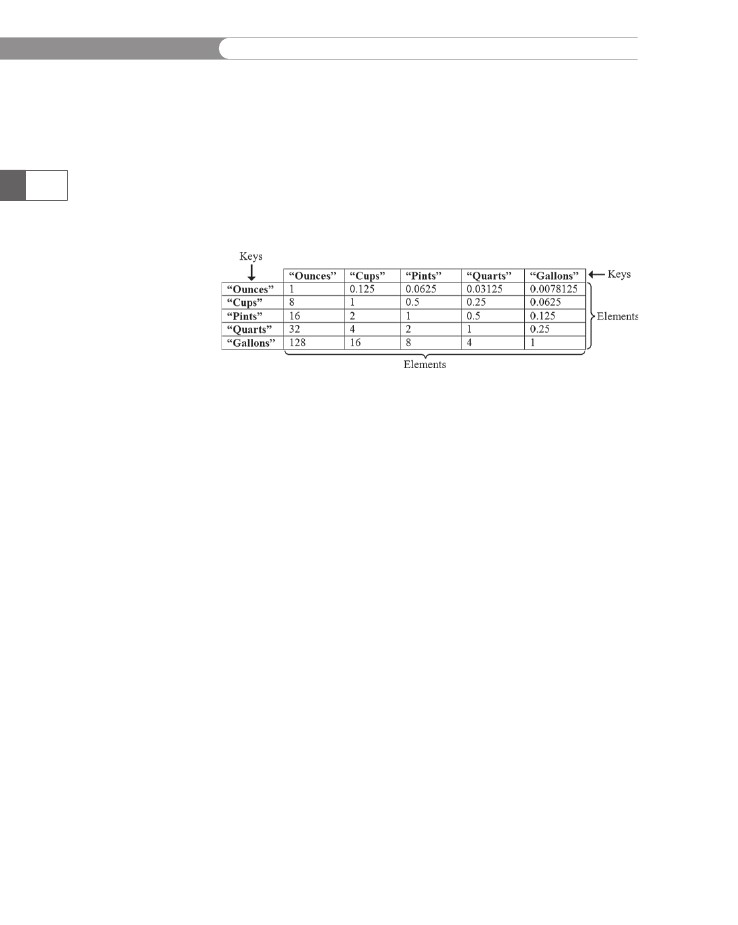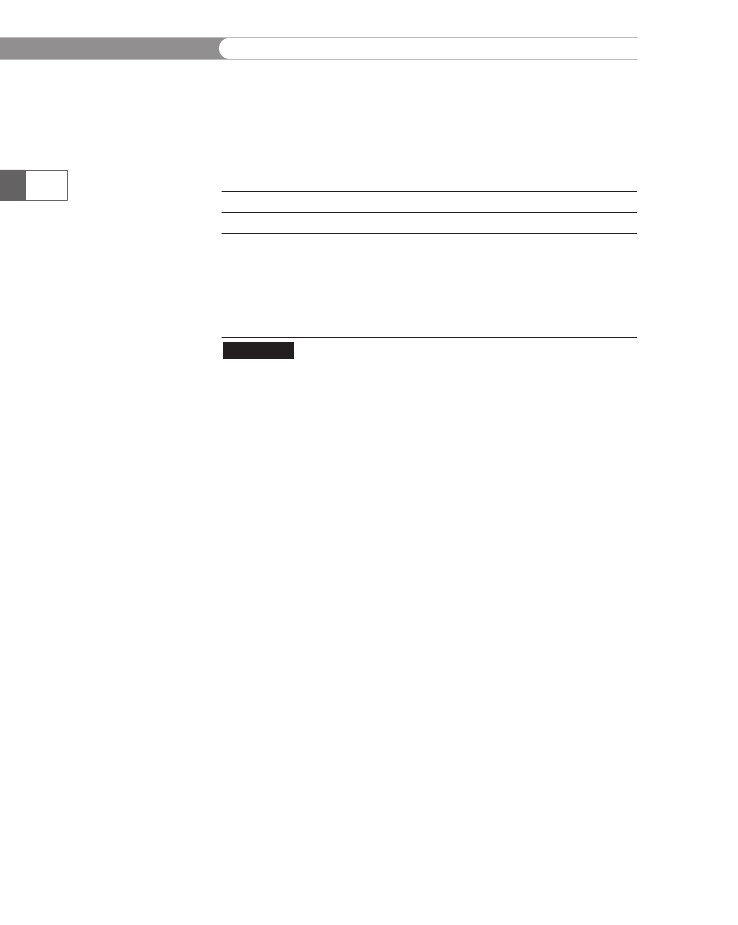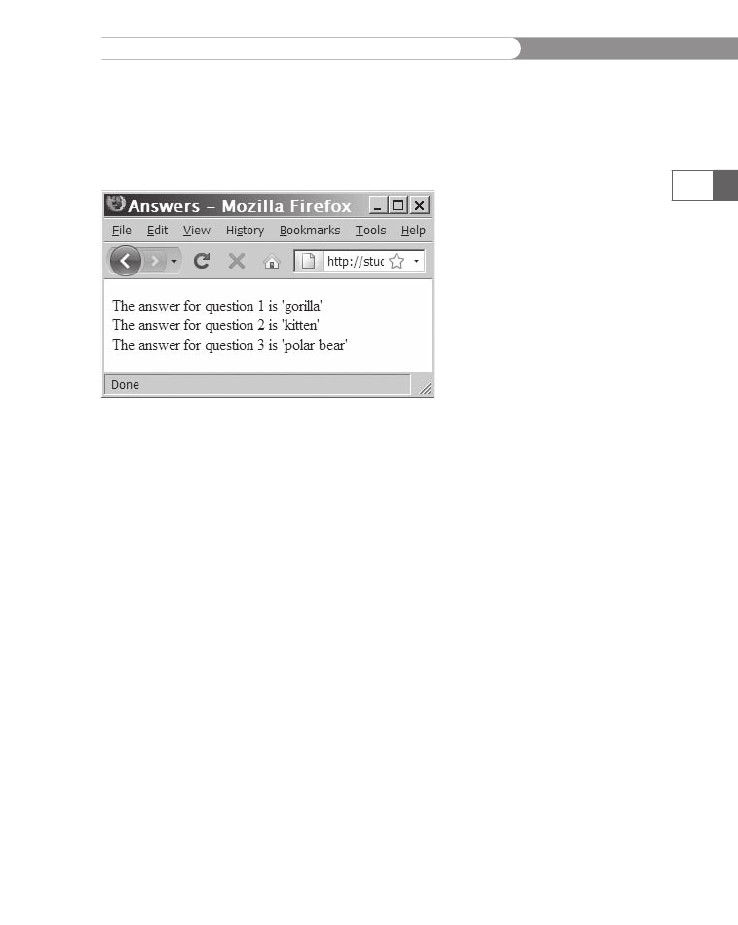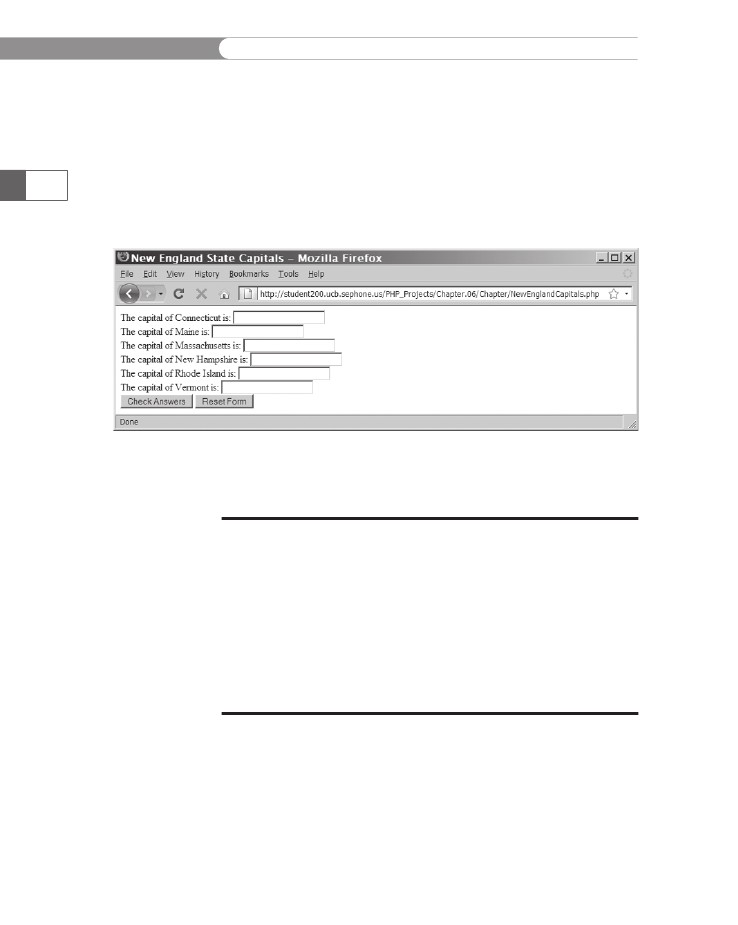
- •Initializing with Constructor Functions . . . . .
- •Into a Web page as a separate section. Although JavaScript code can
- •Is that standard php script delimiters are guaranteed to be available
- •In the block. Any text or lines between the opening /* characters and
- •2.7541 Are not integers; they are floating-point numbers. A floating-
- •Value 300
- •Is a value of 2.5, because 6 goes into 15 exactly 2.5 times. But if you
- •IsEven.Php.
- •Ing example,
- •Ing curly brace is on its own line following the function statements.
- •In php 3 and earlier, it was necessary to put a function definition
- •Is called an iteration. When the conditional expression evaluates
- •Including Files
- •13. Close your Web browser window.
- •Including Files
- •In php, you can also use two operators to combine strings. The first
- •Xhtml source code gen-
- •Input. Php provides several functions for manipulating the case of a
- •Is uppercase. If you need the reverse of ucfirst(), the lcfirst()
- •In some situations, you will need to find and extract characters and
- •Information Interchange, or ascii, which are numeric represen-
- •In comparison, the following preg_match() function returns a value
- •In the pattern is optional. The following code demonstrates how to
- •Values; any strings you validate against a regular expression must
- •Value of 1 because the top-level domain contains a valid value of .Com.
- •Is submitted using the “post” method, the form data is embedded in
- •Validating String Data
- •Xhtml tags or character entities. The message field is a text string
- •Value of the header element. For example:
- •Xhtml code within a php script section.
- •Is typically the person who created the resource. Otherwise, the net-
- •If even a single character of the Web page is sent prior to sending
- •Variables to the file_put_contents() function.
- •Xhtml hyperlink. To download a file from outside the xhtml
- •If...Else statement to display the appropriate version of the mes-
- •Iterating Through an Array
- •Iterating Through an Array
- •In Chapter 2, you learned how to use a foreach statement to iterate
- •Iterating Through an Array
- •Iterating Through an Array
- •In comparison, the following code declares and initializes
- •If ((!file_exists("MessageBoard/messages.Txt"))
- •Values from the array to create a thumbnail gallery of images in which
- •Introduction to Databases
- •Including php, allow you to create Web pages that can read and write
- •Introduction to Databases
- •Information that can be organized into ordered sets of data, and
- •Information. Each recipe in a recipe database, for instance, is a single
- •Introduction to Databases
- •Index, which identifies records in a database to make retrievals and
- •In a single table. However, you might want to break the information
- •Into multiple tables to better organize it into logical sets. Another
- •Information in one of the tables confidential and accessible only by
- •Is the employee information table from Figure 7-1. The related table
- •Is a payroll table that contains confidential salary and compensation
- •Information. Notice that each table contains an identical number of
- •Introduction to Databases
- •Introduction to Databases
- •In a junction
- •Introduction to Databases
- •In a relational format is called a relational database management
- •Is a standard data manipulation language among many dbmSs.
- •Into the query area at the top of the screen or by dragging tables and
- •It is important to understand that even though many dbmSs sup-
- •Introduction to Databases
- •If you ever
- •Is. In comparison, the bigint data type stores integer values between
- •5 Rows in set (0.00 sec)
- •Int);[enter ]
- •Important, these two tabs can cause you to lose all of the data in the
- •Internet Explorer to export the table, click the Save button in the File
- •Ifies the table being changed and the change to make.
- •It easier for you to write php code that can be used with a variety of
- •Information about queries that match one of the following formats:
- •Various types of actions, depending on the type of query.
- •Include fields for the date and time of the flight, flight number, and
- •In the ChineseZodiac folder and upload the file to the server. Open
- •Including white space,
- •Information on a Web server. When you start a new session, the
- •Introduction to Object-Oriented Programming
- •Introduction to Object-Oriented
- •Variables associated with an object are called properties or attributes.
- •In the Loan object example, a function that calculates the number of
- •Introduction to Object-Oriented Programming
- •Introduction to Object-Oriented Programming
- •Include instances of objects inherit the object’s functionality.
- •In this chapter, you will create the Web site for an online order form
- •In an online store application. The application includes information
- •Ity of building a working online store. Online store classes are very
- •Information and products. The OnlineStore class requires that store
- •Information is stored in a table containing six fields: storeId, name,
- •Information. Instead, the class simply uses session iDs to keep track
- •Variable and function as necessary, without bothering with all this
- •In a class
- •Is developed. Imagine what would happen if Microsoft distributed
- •Ing class is invalid because it does not include an access specifier:
- •If they will not be supported by future xhtml versions or are not
- •Xhtml standards. To review the guide of current w3c css specifi-
- •Information to remind yourself or others of what the code is doing. A
- •Xhtml document to the external style sheet. This link informa-
- •If you select Apache from the WampServer menu and select Service
- •Ing code uses the number_format() function to add comma separa-
- •In data that a user submits to a php script.
- •Value of “On” and the display_startup_errors directive is assigned
- •Instead. By looking at the source code, you could see that the value of
- •Ing engine can even help locate logic errors.
- •In Chapter 8, along with the equivalent mssql_* functions, where
- •Inline styles, 632
- •Xhtml, 620–635 (continued)
CHAPTER
6
Manipulating
Arrays
The
if...else
statement
of the completed script should
appear
as follows:
||
(filesize("MessageBoard/messages.txt")If ((!file_exists("MessageBoard/messages.Txt"))
== 0))
echo "<p>There are no messages
posted.</p>\n";
else {
$MessageArray =
file("MessageBoard/messages.txt");
echo "<table
style=\"background-color:lightgray\"
border=\"1\" width=\"100%\">\n";
$count = count($MessageArray);
foreach ($MessageArray as $Message) {
$CurrMsg = explode("~", $Message);
$KeyMessageArray[] = $CurrMsg;
}
for ($i = 0; $i < $count; ++$i) {
echo "<tr>\n";
echo "<td width=\"5%\"
style=\"text-align:center\"><span
style=\"font-weight:bold\">" .
($i + 1) . "</span></td>\n";
echo "<td width=\"85%\"><span
style=\"font-weight:bold\">
Subject:</span> " .
htmlentities(
$KeyMessageArray[$i][0]) .
"<br />";
echo "<span style=\"font-weight:bold\">
Name:</span> " . htmlentities(
$KeyMessageArray[$i][1]) .
"<br />";
echo "<span style=\"font-weight:bold;
text-decoration:underline\">
Message</span><br />" .
htmlentities(
$KeyMessageArray[$i][2]) .
"</td>\n";
echo "<td width=\"10%\"
style=\"text-align:center\"><a
href='MessageBoard.php?" .
"action=Delete%20Message&" .
"message=$i'>Delete This
Message</a></td>\n";
echo "</tr>\n";
}
echo "</table>\n";
}
354
5.
Save the MessageBoard.php file and upload it to the Web
server.
Understanding
Multidimensional Arrays
6.
Open
the MessageBoard.php file in your Web browser by
entering
the following URL: http://<yourserver>/PHP_
Projects/Chapter.06/Chapter/MessageBoard.php.
The message
list
should look the same as it did before you added the two-
dimensional
array.
Close
your Web browser window.
355
7.
Creating
Two-Dimensional Associative Arrays
The
following statements declare the same volume conversion arrays
you
saw earlier, but this time as associative arrays. The primary differ-
ence
in creating two-dimensional associative arrays is that you need
to
specify the key for each element:
$Ounces
= array("ounces" => 1, "cups" => 0.125,
"pints"
=> 0.0625, "quarts" => 0.03125,
"gallons" => 0.0078125);
$Cups = array("ounces" => 8, "cups" => 1,
"pints" => 0.5, "quarts" => 0.25,
"gallons" => 0.0625);
$Pints = array("ounces" => 16, "cups" => 2,
"pints" => 1, "quarts" => 0.5,
"gallons" => 0.125);
$Quarts = array("ounces" => 32, "cups" => 4,
"pints" => 2, "quarts" => 1,
"gallons" => 0.25);
$Gallons = array("ounces" => 128, "cups" => 16,
"pints" => 8, "quarts" => 4,
"gallons" => 1);
You can access elements in the preceding arrays by specifying an
element’s key. For example, you can access the volume conversion
from cups to pints with $Cups["pints"]. Things get a little confusing
when you use the preceding array names to declare and initialize an
associative version of the two-dimensional $VolumeConversions[]
array. For example, the following statement is the same statement you
saw earlier to declare and initialize the indexed version of the two-
dimensional $VolumeConversions[] array:
$VolumeConversions = array($Ounces, $Cups,
$Pints, $Quarts, $Gallons);
Because the preceding statement does not declare keys for the ele-
ments represented by each of the individual arrays, the first dimen-
sion in the resulting $VolumeConversions[] array is indexed and the
second dimension is associative. To access the conversion value from
quarts to cups, you refer to the fourth row (index 3) and second col-
umn (associative key “cups”) of the $VolumeConversions[] function
as follows: $VolumeConversions[3][ "cups"]. Although this syntax

CHAPTER
6
Manipulating
Arrays
is
legal, it can be confusing. To make both dimensions associative,
assign
keys to each of the array names in the statement that declares
and
initializes the $VolumeConversions[]
array,
as follows:
$VolumeConversions
= array("ounces" => $Ounces,
"cups"
=> $Cups, "pints" => $Pints,
"quarts" => $Quarts, "gallons" => $Gallons);
356
Figure 6-21 illustrates the elements and keys in the
$VolumeConversions[] array.
Figure 6-21
Elements and keys of the $VolumeConversions[] array
Assigning keys to each of the array names in the declaration state-
ment for the $VolumeConversions[] array allows you to access the
volume conversion value from quarts to cups by using keys for both
array dimensions. The following statement displays the volume con-
version value from quarts to cups.
echo "<p>1 quart converts to " .
$VolumeConversions["quarts"]["cups"] .
" cups.</p>";
Use the same format to modify an element value in a two-dimen-
sional associative array. The following statement demonstrates how to
modify the volume conversion value from quarts to cups:
$VolumeConversions["quarts"]["cups"] = 4;
Creating Multidimensional Arrays
with a Single Statement
In the preceding two sections, you created multidimensional arrays
using a series of statements. First, you created the individual arrays,
and then you created the multidimensional array itself. You can also
create a multidimensional array with a single statement. Instead of
writing separate declaration statements, you can include the array
construct for each individual array as the value for each element
within the declaration statement for the multidimensional array. The
following example demonstrates how to declare an indexed version
of the multidimensional $VolumeConversions[] array with a single
statement:
Understanding
Multidimensional Arrays
$VolumeConversions
= array(
array(1,
0.125, 0.0625, 0.03125,
0.0078125), // Ounces
array(8, 1, 0.5, 0.25, 0.0625), // Cups
array(16, 2, 1, 0.5, 0.125), // Pints
array(32, 4, 2, 1, 0.25), // Quarts
array(128, 16, 8, 4, 1) // Gallons
);
357
The following example demonstrates how to declare an associative
version of the multidimensional $VolumeConversions[] array with a
single statement:
$VolumeConversions = array(
"ounces" = array("ounces" => 1,
"cups" => 0.125, "pints" => 0.0625,
"quarts" => 0.03125, "gallons" =>
0.0078125),
"cups" = array("ounces" => 8, "cups" => 1,
"pints" =>0.5, "quarts" => 0.25,
"gallons" => 0.0625),
"pints" = array("ounces" => 16, "cups" => 2,
"pints" =>1, "quarts" => 0.5,
"gallons" => 0.125),
"quarts" = array("ounces" => 32, "cups" =>
4, "pints" =>2, "quarts" => 1,
"gallons" => 0.25),
"gallons" = array("ounces" => 128,
"cups" => 16, "pints" =>8, "quarts" =>
4, "gallons" => 1)
);
When creating multidimensional arrays in a single statement, prop-
erly formatting your code is very important. Without proper struc-
ture and indentation, the single-statement declaration is considerably
more difficult to decipher than a series of statements.
Working with Additional Dimensions
Multidimensional arrays are not limited to two dimensions. You can
include as many dimensions as you need when you declare the array.
However, the more dimensions you use, the more complex the array
becomes. Beginning programmers rarely need to use arrays larger
than two dimensions, so this book does not spend much time dis-
cussing how to create them. Nevertheless, you should understand
that the concepts underlying arrays of three or more dimensions are
similar to those for two-dimensional arrays. As an example, consider
an array that stores quarterly sales figures by state for a company’s
five-person sales force. For this type of multidimensional array, you
would need three indexes. The first index would consist of 50 ele-
ments, one for each state. The second index would consist of five
elements, one for each salesperson. The third index would consist of

CHAPTER
6
Manipulating
Arrays
four
elements, one for each quarter in the year. You can think of such
an
array as containing 50 tables, with each table containing a row for
each
salesperson and a column for each quarter. Table 6-5 shows how
the
Alaska table might appear for the first year in an associative ver-
sion
of the array.
358
Quarters
of the year
Q1
Salesperson
Sam
Jane
Lisa
Hiroshi
Jose
Table
6-5
874
656
465
31
654
Q2
76
133
668
132
124
Q3
98
64
897
651
126
Q4
890
354
64
46
456
The
Alaska table of a three-dimensional array
To
create the three-dimensional array, you first declare individual
arrays
for each of the rows in Table 6-5. Then, you create two-dimen-
sional
arrays for each state, which consist of the individual arrays
containing
each salesperson’s figures for that particular state. Finally,
you
create the three-dimensional array by assigning each of the two-
dimensional
state arrays as elements in the three-dimensional array.
The
following statements demonstrate how to build a three-dimen-
sional
array named $AnnualSales[]
for
the state of Alaska. The first
five
statements declare individual arrays for each salesperson’s quar-
terly
figures in the state. The sixth statement creates a two-dimen-
sional
array named $Alaska[]
that
contains the quarterly sales figures
for
each salesperson. The last statement creates a three-dimensional
array
named $AnnualSales[]
by
assigning the two-dimensional
$Alaska[]
array
as an element.
$AlaskaForSam
= array("Q1" => 874, "Q2" => 76,
"Q3"
=> 98, "Q4" => 890);
$AlaskaForJane = array("Q1" => 656, "Q2" => 133,
"Q3" => 64, "Q4" => 354);
$AlaskaForLisa = array("Q1" => 465, "Q2" => 668,
"Q3" => 897, "Q4" => 64);
$AlaskaForHiroshi = array("Q1" => 31, "Q2" => 132,
"Q3" => 651, "Q4" => 46);
$AlaskaForJose = array("Q1" => 654, "Q2" => 124,
"Q3" => 126, "Q4" => 456);
$Alaska = array("Sam" => $AlaskaForSam,
"Jane" => $AlaskaForJane, "Lisa" =>
$AlaskaForLisa, "Hiroshi" =>
$AlaskaForHiroshi, "Jose" =>
$AlaskaForJose);
$AnnualSales["Alaska"] = $Alaska;

Using
Arrays in Web Forms
To
access or modify a value in a three-dimensional array, you must
specify
all dimensions. For example, the following statement displays
Hiroshi’s
third-quarter sales figures for Alaska:
echo
"</p>Hiroshi's third-quarter sales figure
for
Alaska is " .
$AnnualSales['Alaska']['Hiroshi']['Q3'] .
".</p>";
359
PHP differs from most other computer languages in its use of multi-
dimensional arrays. Most other languages require that each row have
the same number of columns. PHP is more flexible, allowing each
row to have as many or as few records as needed. PHP also does not
require that all rows use the same keys or indexes to refer to a specific
column. Although this flexibility is very useful in the right situations,
it is usually best to use a consistent number of columns with the same
keys or indexes.
Short Quiz
1.
What is the difference between a one-dimensional array and a
multidimensional array?
What is the most common type of multidimensional array?
In a two-dimensional array, the first set of indexes can be
thought of as, and the second set of indexes
can be thought of as. (Fill in the blanks.)
What is the primary difference between creating two-dimen-
sional associative arrays and two-dimensional indexed arrays?
Explain how to create a two-dimensional array in a single
statement.
2.
3.
4.
5.
Using Arrays in Web Forms
One of the most useful features of PHP arrays is that you can use
them with XHTML form input elements. This is convenient when
you have multiple matching input fields, such as the item rows in an
online order form. Several syntaxes may be used, depending on how
you want the array to be created in PHP.
To have PHP store the form data in an array, you modify the name
attribute of the input element to use array notation. If the indexes
CHAPTER
6
Manipulating
Arrays
of
the array elements are unimportant, you only need to append an
opening
and closing square bracket ([])
to the value of the name
attri-
bute.
The data from any element with the same value for the name
attribute
will be appended to an array with that name.
360
For
example, the following XHTML form code creates three input
text
boxes, for which the entered text will be stored as an array in
$_POST['answers']:
<form
method='post' action='ProcessForm.php'>
<p>Enter
the first answer:
<input
type='text' name='answers[]' /></p>
<p>Enter
the second answer:
<input
type='text' name='answers[]' /></p>
<p>Enter
the third answer:
<input
type='text' name='answers[]' /></p>
<input
type='submit' name='submit'
value='submit'
/>
</form>
When a form with input elements that use array notation for the
value of the name attribute is processed within PHP, the data values
for the input elements are stored in a nested array within the $_POST
autoglobal array. The array is accessed by using the name specified in
the name attribute without the square brackets as the associative array
key for the $_POST array. For example, to access the array of answers
from the previous example, you use $_POST['answers'].
Because no indexes or keys are entered in the value of the name attri-
bute in the original form, PHP assigns an index of 0 to the first ele-
ment, 1 to the second, and so forth. This is the equivalent of using
the syntax answers[]='Some Text'; to assign the value of an array
element within PHP.
As a nested array within the $_POST array, all of the standard PHP
array notation and functions can be applied to the element of the
$_POST array. Consider the following code:
if (is_array($_POST['answers'])) {
$Answers = $_POST['answers'];
if (is_array($Answers)) {
$Index = 0;
foreach ($Answers as $Answer) {
++$Index;
echo "The answer for question " .
" $Index is '" .
htmlentities($Answer) .
"'<br />\n";
}
}
}

Using
Arrays in Web Forms
In
this example, because there are three input text fields on the
origi-
nal
form, three lines will be displayed. The data will be displayed in
the
order posted, which is the order in which the input elements
occur
on the original Web form. Figure 6-22 shows an example out-
put
with the answers “gorilla”, “kitten”, and “polar bear”.
361
Figure
6-22
Output
of an array posted from a Web form
Multidimensional
array notation can also be used to process the
posted
form information. The following code produces the same
results
as the foreach
example
above, but uses multidimensional
array
notation, the count()
function,
and a for
loop.
The output for
this
example will look identical to the output of the previous example.
if
(is_array($_POST['answers'])) {
$Answers
= $_POST['answers'];
if (is_array($Answers)) {
$count = count($Answers);
for ($i = 0; $i < $count; ++$i) {
echo "The answer for question " .
($i+1) . " is '" .
htmlentities($Answers[$i]) .
"'<br />\n";
}
}
}
If the order of the form inputs is important, you can include either
an index or an associative key between the opening and closing
array brackets. When using associative keys in Web forms, you do
not use quotes around the associative array key name. The syntax
<input type='text' name='answers[Q1]' /> will work, but the
syntax <input type='text' name='answers['Q1']' /> will not.
For example, the following code will ensure that indexes 1, 2, and 3
are associated with answers 1, 2, and 3, respectively:
CHAPTER
6
Manipulating
Arrays
<form
method='post' action='ProcessForm.php'>
<p>Enter
the first answer:
<input
type='text' name='answers[1]' /></p>
<p>Enter
the second answer:
<input
type='text' name='answers[2]' /></p>
<p>Enter
the third answer:
<input
type='text' name='answers[3]' /></p>
<input
type='submit' name='submit'
value='submit'
/>
</form>
362
The following code will associate the key ‘Question 1’ with the first
answer, ‘Question 2’ with the second answer, and ‘Question 3’ with
the third answer:
<form method='post' action='ProcessForm.php'>
<p>Enter the first answer:
<input type='text' name='answers[Question 1]'
/></p>
<p>Enter the second answer:
<input type='text' name='answers[Question 2]'
/></p>
<p>Enter the third answer:
<input type='text' name='answers[Question 3]'
/></p>
<input type='submit' name='submit'
value='submit' />
</form>
To create an All-in-One Web form quiz about the capitals of the New
England states:
1.
2.
Create a new document in your text editor.
Type the <!DOCTYPE> declaration, <html> element, header
information, and <body> element. Use the strict DTD and
“New England State Capitals” as the content of the
<title>element.
Add the following script section to the document body:
<?php
?>
3.
4.
Add the following code to the script section to declare an
associative array of the New England state capitals:
$StateCapitals = array(
"Connecticut" => "Hartford",
"Maine" => "Augusta",
"Massachusetts" => "Boston",
"New Hampshire" => "Concord",
"Rhode Island" => "Providence",
"Vermont" => "Montpelier"
);
Using
Arrays in Web Forms
5.
Add
the following if...else
statement
to determine if the
answers
have been posted:
if
(isset($_POST['submit'])) {
}
else
{
}
363
6.
Add
the following code to the if
clause
of the if...else
statement
to validate the answers:
$Answers
= $_POST['answers'];
if
(is_array($Answers)) {
foreach
($Answers as
$State => $Response) {
$Response =
stripslashes($Response);
if (strlen($Response)>0) {
if (strcasecmp(
$StateCapitals[$State],
$Response)==0)
echo "<p>Correct! The
capital of $State is " .
$StateCapitals[$State] .
".</p>\n";
else
echo "<p>Sorry, the capital
of $State is not '" .
$Response . "'.</p>\n";
}
else
echo "<p>You did not enter a
value for the capital of
$State.</p>\n";
}
}
echo "<p><a href='NewEnglandCapitals.php'>
Try again?</a></p>\n";
7.
Add the following code to the else clause of the if...else
statement to display the Web form:
echo "<form action='NewEnglandCapitals.php'
method='POST'>\n";
foreach ($StateCapitals as
$State => $Response)
echo "The capital of $State is:
<input type='text' name='answers[" .
$State . "]' /><br />\n";
echo "<input type='submit'
name='submit'
value='Check Answers' /> ";
echo "<input type='reset' name='reset'
value='Reset Form' />\n";
echo "</form>\n";

CHAPTER
6
Manipulating
Arrays
8.
Save
the document as NewEnglandCapitals.php in the
Chapter
directory for Chapter 6 and upload the file to the
server.
Open
the NewEnglandCapitals.php file in your Web browser
by
entering the following URL: http://<yourserver>/PHP_
Projects/Chapter.06/Chapter/NewEnglandCapitals.php.
Figure
6-23 shows the form. Enter your answers and click the
Check
Answers button to see how you did.
9.
364
Figure
6-23
The
“New England Capitals” quiz Web form
10.
Close
your Web browser window.
Short
Quiz
1.
What
attribute in the Web form <input>
tag
must be changed
for
the value to be sent as an array element?
Can
arrays created from Web forms be indexed arrays, asso-
ciative
arrays, or both? Explain.
Should
quotation marks be used in the associative array key
name
for a Web form? Why or why not?
2.
3.
Summing
Up
Summing
Up
•
The
beginning of an array, whereas the array_unshift() function adds
one or more elements to the beginning of an array.
• The
array_pop() function removes the last element from the endof an array, whereas the array_push() function adds one or more
elements to the end of an array.
• The
array_splice() function adds or removes array elements.• The
unset() function removes array elements and other variables.• The
array_values() function renumbers an indexed array’selements.
• The
array_unique() function removes duplicate elements froman array.
• With associative arrays, you specify an element’s key by using the
array operator (=>).
• The internal array pointer refers to the currently selected element
in an array.
• The
in_array() function returns a Boolean value of TRUE if a givenvalue exists in an array.
• The
array_search() function determines whether a given valueexists in an array and 1) returns the index or key of the first match-
ing element if the value exists, or 2) returns FALSE if the value does
not exist.
• The
array_key_exists() function determines whether a givenindex or key exists.
• The
array_slice() function returns a portion of an array andassigns it to another array.
• The most commonly used array sorting functions are
sort()and rsort() for indexed arrays, and ksort() and krsort() for
associative arrays.
• To append one array to another, you use the addition (
+) or thecompound assignment (+=) operator.
• The
array_merge() function merges two or more arrays.• The
array_diff() function returns an array of elements that existin one array but not in any other arrays to which it is compared.
• The
array_intersect() function returns an array of elements thatexist in all of the arrays that are compared.
365
CHAPTER
6
Manipulating
Arrays
•
A
multidimensional array consists of multiple indexes or keys.
• When array notation is used in the name of a Web form input, the
value gets stored in a nested array within the $_POST or $_GET array.
• When using associative array notation in a Web form, you omit
the quotation marks around the key name.
366
Comprehension Check
1.
Which of the following functions removes the first element
from the beginning of an array?
a. array_shift()
b. array_unshift()
c. array_push()
d. array_pop()
2.
Explain the easiest way to add elements to the end of an
indexed array.
Which of the following functions removes the last element
from the end of an array? (Choose all that apply.)
a. array_shift()
b. array_unshift()
c. array_push()
d. array_pop()
4.
Explain how to use the array_splice() function to add and
remove elements to and from an array.
After removing elements from an array, the unset() function
automatically renumbers the remaining elements. True or
False?
Which of the following functions removes duplicate elements
from an array?
a. array_duplicates()
b. array_unique()
c. remove_duplicates()
d. unique()
3.
5.
6.
Comprehension
Check
7.
What
is the correct syntax for declaring and initializing an
associative
array?
a.
$AutoMakers
= array(“Ford”
.
“Mustang”,
“Chevrolet”
.
“Corvette”);
b.
$AutoMakers
= array(“Ford”
=
“Mustang”,
“Chevrolet”
=
“Corvette”);
c.
$AutoMakers
= array(“Ford”
>
“Mustang”,
“Chevrolet”
>
“Corvette”);
d.
$AutoMakers
= array(“Ford”
=>
“Mustang”,
“Chevrolet”
=>
“Corvette”);
367
8.
If
an array contains a mixture of indexes and keys, what value
or
key is used if you do not specify one when adding a new
element
to the array?
If
you declare an array in PHP and use a starting index other
than
0, empty elements are created for each index between 0
and
the index value you specify. True or False?
9.
10.
Which of the following functions moves an array’s internal
pointer
to the first element?
a. first()
b. top()
c. start()
d. reset()
11. Which of the following functions returns the value of an ele-
ment where an array’s internal pointer is positioned?
a. current()
b. key()
c. array()
d. array_values()
12. Explain the difference between the in_array() and
array_search() functions.
CHAPTER
6
Manipulating
Arrays
13.
Which of the following locates a key named “Ford” in an array
named
a. array_key_exists($AutoMakers => “Ford”);
b. $AutoMakers = array_key_exists(“Ford”);
368
c. array_key_exists($AutoMakers, “Ford”);
d. array_key_exists(“Ford”, $AutoMakers);
14. Explain how to use the array_slice() function to return a
portion of an array and assign it to another array.
15. Which of the following functions performs a reverse sort on
an array? (Choose all that apply.)
a. asort()
b. usort()
c. rsort()
d. krsort()
16. Which of the following operators can you use to append one
array to another? (Choose all that apply.)
a. .
b. +
c. +=
d. =>
17. If you use the array_merge() function with indexed arrays,
all elements in one array are appended to another array and
renumbered. True or False?
18. Which of the following returns an array of elements that exist
in all of the arrays that are compared?
a. usort()
b. array_common()
c. array_diff()
d. array_intersect()

Reinforcement
Exercises
19.
Suppose you are working with an indexed two-dimensional
array
named
begins with an index of 0. Which of the following refers to the
second element in the first dimension and the third element
in the second dimension?
a. $InterestRates[1],[2]
b. $InterestRates[1][2]
c. $InterestRates[1, 2]
d. $InterestRates[1].[2]
20. Which is the correct Web form syntax for creating the auto-
global element
$_POST['item']['quantity']?a. <input type="text" name="item['quantity']" />
b. <input type="text" name='item["quantity"]' />
c. <input type="text" name='item[quantity]' />
d. <input type="text" name="item["quantity"]" />
369
Reinforcement Exercises
Exercise 6-1
Create a Song Organizer script that stores songs in a text file. Include
functionality that allows users to view the song list and prevents the
same song name from being entered twice. Also, include code that
sorts the songs by name, deletes duplicate entries, and randomizes
the song list with the shuffle() function.
1.
2.
Create a new document in your text editor.
Type the <!DOCTYPE> declaration, <html> element, header
information, and <body> element. Use the strict DTD and
“Song Organizer” as the content of the
<title> element.Add the following XHTML code and script section to the
document body:
<h1>Song Organizer</h1>
<?php
?>
3.
CHAPTER
6
Manipulating
Arrays
4.
Add
the following code to the script section to handle any
parameters
in the URL:
if
(isset($_GET['action'])) {
if
((file_exists("SongOrganizer/songs.txt"))
&& (filesize("SongOrganizer/songs.txt")
!= 0)) {
$SongArray = file(
"SongOrganizer/songs.txt");
switch ($_GET['action']) {
} // End of the switch statement
}
}
370
5.
Add the following code to the body of the switch statement
to handle the three options (Sort Ascending, Remove
Duplicates, and Shuffle):
case 'Remove Duplicates':
$SongArray = array_unique(
$SongArray);
$SongArray = array_values(
$SongArray);
break;
case 'Sort Ascending':
sort($SongArray);
break;
case 'Shuffle':
shuffle($SongArray);
break;
6.
Add the following code immediately after the switch state-
ment to save the song list after it has been modified:
if (count($SongArray)>0) {
$NewSongs = implode($SongArray);
$SongStore = fopen(
"SongOrganizer/songs.txt",
"wb");
if ($SongStore === false)
echo "There was an error
updating the song file\n";
else {
fwrite($SongStore, $NewSongs);
fclose($SongStore);
}
}
else
unlink("SongOrganizer/songs.txt");

Reinforcement
Exercises
7.
Add
the following code to the end of the script section to
handle
any data submitted from the Web form:
if
(isset($_POST['submit'])) {
$SongToAdd
= stripslashes(
$_POST['SongName']) . "\n";
$ExistingSongs = array();
if (file_exists("SongOrganizer/songs.txt")
&& filesize("SongOrganizer/songs.txt")
> 0) {
$ExistingSongs = file(
"SongOrganizer/songs.txt");
}
}
371
8.
Add the following if statement immediately after the block
where the song file data was read into the $ExistingSongs
array. This if statement checks to see if the song name
entered is already in the song list, and displays a message if
the song already exists.
if (in_array($SongToAdd, $ExistingSongs)) {
echo "<p>The song you entered already
exists!<br />\n";
echo "Your song was not added to the
list.</p>";
}
Although this
form does not
allow for dupli-
cate entries,
you still need
to be able to remove
them if necessary. There
may be other methods of
adding songs to the list,
and the other methods
may allow duplicate
entries.
9.
Add the following else clause to the preceding if statement.
This else clause adds the new song to the song list file.
else {
$SongFile = fopen(
"SongOrganizer/songs.txt", "ab");
if ($SongFile === false)
echo "There was an error saving
your message!\n";
else {
fwrite($SongFile, $SongToAdd);
fclose($SongFile);
echo "Your song has been added to
the list.\n";
}
}
CHAPTER
6
Manipulating
Arrays
10.
Add the following code to the end of the script section to dis-
play
the song list, or a message that there are no songs in the
list if the list is empty:
if ((!file_exists("SongOrganizer/songs.txt"))
|| (filesize("SongOrganizer/songs.txt")
== 0))
echo "<p>There are no songs in the
list.</p>\n";
else {
$SongArray = file(
"SongOrganizer/songs.txt");
echo "<table border=\"1\" width=\"100%\"
style=\"background-color:lightgray\">\n";
foreach ($SongArray as $Song) {
echo "<tr>\n";
echo "<td>" . htmlentities($Song) .
"</td>";
echo "</tr>\n";
}
echo "</table>\n";
}
372
11. Add the following XHTML code immediately after the PHP
script section to display hyperlinks for the three functions in
the switch statement (Sort Ascending, Remove Duplicates,
and Shuffle):
<p>
<a href="SongOrganizer.php?action=Sort%20Ascending">
Sort Song List</a><br />
<a href="SongOrganizer.php?action=Remove%20Duplicates">
Remove Duplicate Songs</a><br />
<a href="SongOrganizer.php?action=Shuffle">
Randomize Song list</a><br />
</p>
12. Next, add the following XHTML code to create a Web form
for entering new song names into the song list:
<form action="SongOrganizer.php" method="post">
<p>Add a New Song</p>
<p>Song Name: <input type="text" name="SongName"
/></p>
<p><input type="submit" name="submit"
value="Add Song to List" />
<input type="reset" name="reset"
value="Reset Song Name" /></p>
</form>
13. Save the document as SongOrganizer.php in the Projects
directory for Chapter 6 and upload the file to the server.

Reinforcement
Exercises
14.
Open the SongOrganizer.php file in your Web browser by
entering
the following URL: http://<yourserver>/PHP_
Projects/Chapter.06/Projects/SongOrganizer.php.
15. Close your Web browser window.
Exercise 6-2
In this project, you will create a multidimensional array that contains
the measurements, in inches, for several boxes that a shipping com-
pany might use to determine the volume of a box.
1.
2.
Create a new document in your text editor.
Type the <!DOCTYPE> declaration, <html> element, docu-
ment head, and <body> element. Use the strict DTD and “Box
Array” as the content of the <title> element.
Create a script section in the document body:
<?php
?>
373
3.
4.
Declare and initialize an associative multidimensional array
using the information shown in the following table:
Length
Small box
Medium box
Large box
12
30
60
Width
10
20
40
Depth
2.5
4
11.5
5.
6.
7.
Add statements to the end of the script section that display
the volume (length * width * depth) of each box.
Save the document as BoxArray.php in the Projects directory
for Chapter 6, and then close the document in your text editor.
Open the BoxArray.php file in your Web browser by enter-
ing the following URL: http://<yourserver>/PHP_Projects/
Chapter.06/Projects/BoxArray.php.
Close your Web browser window.
8.
Exercise 6-3
Create a Web form that shows the mileage between European capi-
tals. Use a two-dimensional associative array to store the mileages.
1.
Create a new document in your text editor.
CHAPTER
6
Manipulating
Arrays
2.
Type
the <!DOCTYPE>
declaration,
<html>
element,
header
information,
and <body>
element.
Use the strict DTD and
“European
Travel” as the content of the
Add the following script section to the document body:
<?php
?>
3.
374
4.
Add the following code to the script section to declare an
associative array of European cities and the distances between
them in kilometers, and the conversion factor for kilometers
to miles:
$Distances = array(
"Berlin" => array(
"Berlin" => 0,
"Moscow" => 1607.99,
"Paris" => 876.96,
"Prague" => 280.34,
"Rome" => 1181.67
),
"Moscow" => array(
"Berlin" => 1607.99,
"Moscow" => 0,
"Paris" => 2484.92,
"Prague" => 1664.04,
"Rome" => 2374.26
),
"Paris" => array(
"Berlin" => 876.96,
"Moscow" => 641.31,
"Paris" => 0,
"Prague" => 885.38,
"Rome" => 1105.76
),
"Prague" => array(
"Berlin" => 280.34,
"Moscow" => 1664.04,
"Paris" => 885.38,
"Prague" => 0,
"Rome" => 922
),
"Rome" => array(
"Berlin" => 1181.67,
"Moscow" => 2374.26,
"Paris" => 1105.76,
"Prague" => 922,
"Rome" => 0
)
);
$KMtoMiles = 0.62;
Reinforcement
Exercises
5.
Add
the following if
statement
to process the entered cities:
if
(isset($_POST['submit'])) {
$StartIndex
= stripslashes($_POST['Start']);
$EndIndex = stripslashes($_POST['End']);
if (isset(
$Distances[$StartIndex][$EndIndex]))
echo "<p>The distance from $StartIndex
to $EndIndex is " .
$Distances[$StartIndex][$EndIndex]
. " kilometers, or " . round(
($KMtoMiles *
$Distances[$StartIndex][$EndIndex]),
2) . " miles.</p>\n";
else
echo "<p>The distance from $StartIndex
to $EndIndex is not in the
array.</p>\n";
}
375
6.
Add the following XHTML code after the PHP script to dis-
play the Web form:
<form action="EuropeanTravel.php" method="post">
<p>Starting City:
<select name="Start">
</select></p>
<p>Ending City:
<select name="End">
</select></p>
<p><input type="submit" name="submit"
value="Calculate Distance" /></p>
</form>
7.
Add the following PHP script between the opening and clos-
ing XHTML tags for the “Start” <select> element to insert
the list of city names:
<?php
foreach ($Distances as
$City => $OtherCities) {
echo "<option value='$City'";
if (strcmp($StartIndex,$City)==0)
echo " selected";
echo ">$City</option>\n";
}
?>
8.
Add the following PHP script between the opening and clos-
ing XHTML tags for the “End” <select> element to insert the
list of city names:

CHAPTER
6
Manipulating
Arrays
<?php
foreach
($Distances as
$City
=> $OtherCities) {
echo "<option value='$City'";
if (strcmp($EndIndex,$City)==0)
echo " selected";
echo ">$City</option>\n";
}
?>
376
9.
Save the document as EuropeanTravel.php in the Projects
directory for Chapter 6 and upload the file to the server.
10. Open the EuropeanTravel.php file in your Web browser
by entering the following URL: http://<yourserver>/PHP_
Projects/Chapter.06/Projects/EuropeanTravel.php.
11. Close your Web browser window.
Exercise 6-4
Use the techniques you learned in this chapter to create a Guest Book
script that stores visitor names and e-mail addresses in a text file.
Include functionality that allows users to view the guest book and
prevents the same user name from being entered twice. Also, include
code that sorts the guest book by name and deletes duplicate entries.
Exercise 6-5
Create an online order form as a Web form. Allow visitors to enter a
quantity for at least five items for sale. Each item should have a name,
description, and price. The form should have buttons to update the totals
for the quantities entered and to submit the order. Save the orders to a
subdirectory called OnlineOrders in the Projects directory for Chapter
6. Use the date and time to create a unique filename for each order.
Discovery Projects
The Chinese Zodiac site is a comprehensive project that will be
updated in the Discovery Projects in each chapter. All files for the
Chinese Zodiac site will be saved in a folder named ChineseZodiac in
the root Web folder on the server.
Discovery Project 6-1
Reopen inc_footer.php from the Includes folder and use the array
constructs introduced in Chapter 6 to randomly display a dragon

Discovery
Projects
image
below the randomly displayed Chinese proverbs each time the
browser
is refreshed. Use the small dragon images that you uploaded
to
the Images folder in Discovery Project 5-6.
Use
the functions you learned in Chapter 5 to read the filenames
from
the Images folder into an array. Because you have other images
in
the Images folder besides your dragon images, you should filter
the
contents of the folder to add only files that have a filename of
Dragon1,
Dragon2, etc., and a valid image extension before adding
them
to your array. The easiest way to filter the filenames is to use a
regular
expression such as '/ˆDragon\d+\.(gif|jpg|png)$/'.
When
the
array is populated, use the shuffle()
function
to randomly reor-
der
the array. Select the name in the first array element of the shuffled
array
as the random image to display.
377
Discovery
Project 6-2
Open
a new document in your text editor and create an All-in-One
form
that prompts the user to enter the 12 zodiac signs in random
order
in a text box. The signs must be separated with commas.
Inform
the user that you will display the signs in an alphabetized list
after
the form has been submitted.
Use
the array sort functions introduced in this chapter to alphabetize
the
signs and then display them in an ordered list.
Save
the file as AlphabetizeSigns.php and upload the file to the
ChineseZodiac
folder on the Web server.
Reopen
inc_web_forms.php from the Includes folder and replace
the
“[Insert Web forms content here]” placeholder with Web content
that
describes the processing of user input on a Web page. Include a
description
of how to create and process a Web form.
Add
a section called “Alphabetizing User Input” and briefly
describe
the
function of the AlphabetizeSigns.php script. Refer to Discovery
Project
5-4 to add “[Test the Script]” and “[View the Source Code]”
links
below the descriptive data.
Add
a text navigation bar at the top of the document with an internal
link
to the “Alphabetizing User Input” section.
Save
the inc_web_forms.php file and upload it to the server. The con-
tents
of this file should appear in the dynamic content section when
you
click the Web Forms button or the Web Forms text hyperlink
from
the Chinese zodiac Web template.
